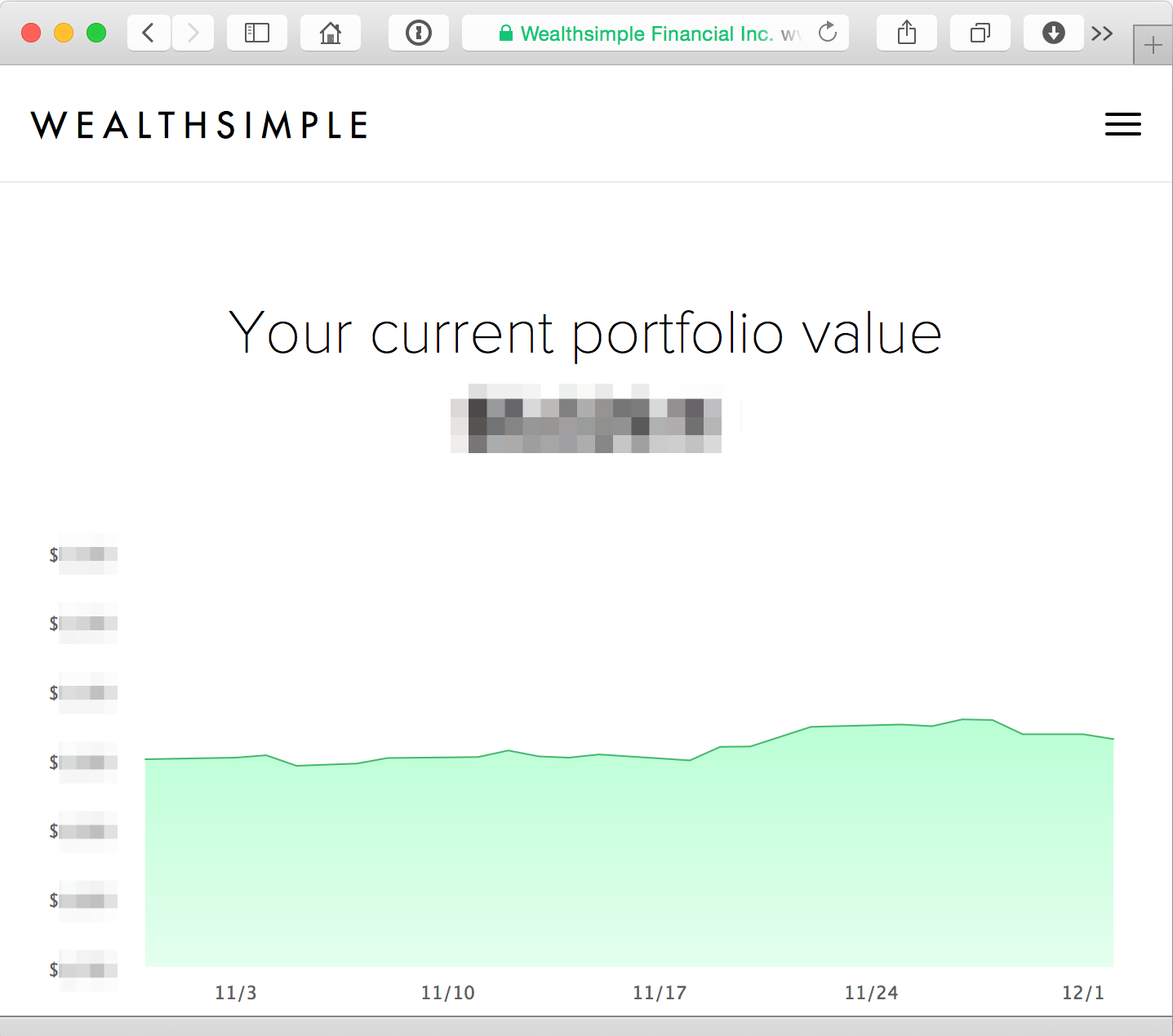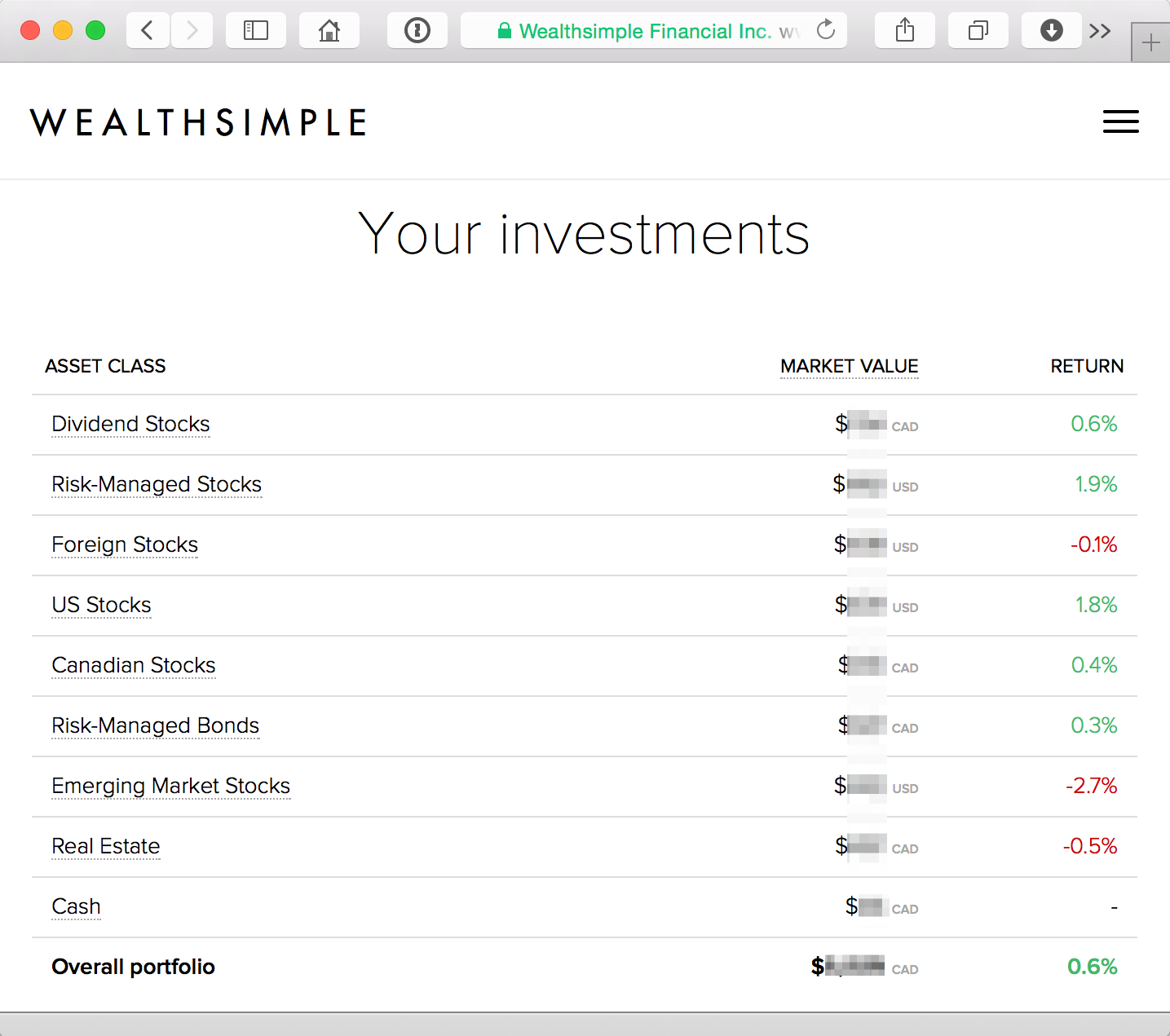Wealthsimple Review
I've been watching the ascent of automated index investing services (e.g. Wealthfront) in the United States with keen interest, and I have been looking forward to the arrival of similar services in Canada. The value proposition is pretty straightfoward: you invest in securities (i.e. ETFs) in accordance with your savings goals, time horizon, risk tolerance, etc – and they take care of the messy details such as trading, rebalancing, and even tax-loss harvesting. Because computers are involved, and automating this process, it can be done very cheaply and efficiently, but more importantly: sans any human emotion – so often the destroyer of portfolio returns.
So long as you are convinced by the soundness1 of index investing as a strategy – and I invite the skeptic to examine the boatloads of evidence to that effect – there is a lot to like about this concept. When I heard about Wealthsimple's launch in Canada, I immediately signed up to try it out.
As with anything I write on the topic of finance or investing – this is all just a layperson's opinion – not the provision of advice. Do your own research, or consult with a trusted, qualified advisor.
First Impressions
I've long been a critic of bad software, and in particular bad software in financial services. It amazes me that these organizations, with such vast market capitalizations and elephantine top and bottom lines, still mostly have web applications straight out of 2004 – putting it charitably.
Wealthsimple is, refreshingly, a company that appears to get it in this regard. Right on the landing page are some positive indicators: an EV TLS certificate, responsive design, good typography. This is all necessary but not sufficient of course, i.e. certainly not proof-positive of the company's engineering and/or financial acumen – but it is very encouraging on a first-impressions basis2.
Onboarding Process
Getting signed up was pretty smooth, and involved zero pieces of physical paper3. They walk you through a progression of steps where you verify identification, prove ownership of your bank account, and so on. At any given point, it's very clear how things are progressing. Given the fairly strict requirements on identify verification and so on in financial services – this is about as pleasant a process as one could hope for.
As part of the signup, new users also participate in a risk tolerance questionnaire – fairly standard stuff. I can't meaningfully comment on this as I have my own well-established opinions in that area.
Wealthsimple differs from its peers – certainly Wealthfront – in at least one important way: investors have access to an advisor figure who can, presumably, offer advice on matters relating to financial milestones and tax optimization. As part of the onboarding process, they invite you to schedule a brief call with your assigned advisor. I'm not sure to what extent this person is available to the investor, and to what extent their advice is personalized, but their presence is surely comforting to any investor keen to escape the fleecing4 of their 2.5% MER mutual funds, but is not quite ready to be fully self-directed.
Investing
With your risk tolerance identified, Wealthsimple builds a portfolio by transacting ETFs on your behalf.
There's a lot to like here; XIC and VTI are used for Canadian and US equity respectively. These are large, diverse total stock market indices with ultra-cheap 0.05% MERs5. Moreover, they trade in USD-based securities where appropriate – presumably after first converting cheaply. This is advantageous, not only for currency diversification reasons, but also for eliminating US dividend-withholding in RRSPs.
Other choices in the portfolio – I'm not so sure. For example, the category of Risk-Managed Stocks has the descriptor 'uses a momentum-based strategy designed to protect investors against big market downturns', which sounds awfully active-management to me. Given that I essentially subscribe to the weak efficient-market hypothesis, and believe stochastic forecasting is impossible – this is problematic for my own personal investing philosophy. Others may well differ on this point.
Regardless of the ultimate performance of these more exotic securities - their management doesn't come especially cheap. Their presence inflates the weighted MER of the portfolio in my account to 0.3622%. Speaking of pricing:
Pricing
Wealthsimple has various offerings depending on the size of the portfolio under management, but generally speaking:
- investors pay a management fee of
0.5%; less on Premium (above $100k) or above portfolios - automated tax-loss harvesting is included with Premium accounts and above
- ETF trading fees are not charged; this is covered by Wealthsimple6
- The management fee is not inclusive of the MER of the underlying ETFs, so it's really
0.5% + 0.3622%, assuming the same portfolio as mine in Wealthsimple.
Here is how Wealthsimple's portfolio fees compare to other options. These options are discussed in more detail at Canadian Couch Potato, and I won't replicate that here. I operate in the Low-cost Index ETF category myself.
| Method | Weighted MER (Approx %) |
| Typical Mutual Funds | 2.5 |
| Tangerine Mutual Funds | 1.07 |
| Wealthsimple (MER + fee) | 0.85 |
| TD e-series Mutual Funds | 0.44 |
| Low-cost Index ETFs | 0.18 |
Wealthsimple is undoubtedly far, far cheaper than the most egregious mutual fund offerings to be found in this country. However, it remains quite a bit more expensive than either a TD e-series portfolio, or a low-cost ETF portfolio. Obviously this isn't an apples-to-apples comparison; Wealthsimple automates much of the work and provides access to an advisor – neither of which is available in the cheaper options above. The more exotic ETF choices are harder for me to justify. Ultimately, it's up to the individual investor whether the value justifies the cost based on their needs and philosophy. There's nothing wrong with paying more to get a better level of service or experience, so long as one is aware that seemingly small percentages in fact compound rather substantially.
As it stands, right now I still see TD e-series remaining in the sweet spot, given its low cost and relative lack of maintenance required.
Would I Use It?
I'll probably keep my initial deposit invested as an experiment, but I'm unlikely to go all-in on it with my entire portfolio. Leaving aside my investment objections raised above, I'm ultimately not really the target market. I'm a finance geek – I like executing trades, efficiently converting currency, manually rebalancing – this stuff is interesting and intellectually rewarding to me. Saving roughly sixty basis points for doing this on my own is simply a bonus for doing something I'm inclined towards anyway.
Conclusion
I'll be following Wealthsimple's progress with great interest. I can object about their precise portfolio choices, or the size of their fee in relation to other alternatives, but these aspects of the service needn't be permanently fixed. I would like to see them at least offer a more traditional indexed option aside from what they have. Of particular interest to me is if they can find a way to enable frequent, dollar-cost averaged purchases – crucially with a good solution for calculating adjusted cost-bases in non-registered accounts. This is a very difficult thing to achieve elsewhere, even at TD e-series.
Taken as a whole, it seems to me that they've built the beginnings of something great. However their offerings play out, the fees that most investors in this country pay, often-unwittingly, are eye-wateringly high, so it seems to me there is a pretty substantial price umbrella for Wealthsimple to comfortably sit under! Investing is a natural place for software to be deployed, and after wistfully observing the US-market progress on this front, I'm happy to see Canada start to catch up. I wish Wealthsimple the best of luck – innovation in the customer facing part of banking and investing is always appreciated, and seems to be oddly rare among the incumbents.
-
To what extent Wealthsimple truly adheres to indexing is not fully clear, as explored below. ↩
-
Especially to me, as I'm immersed in web application engineering and infrastructure daily. ↩
-
I went paperless over a year ago, so this is always appreciated. ↩
-
This is about the least harsh word I can reasonably apply here. ↩
-
That's a fee of $5 for every $10,000 invested. It doesn't get much better than that. ↩
-
Self-directed investors typically pay $9.95 or so for a trade, so this represents a cost saving. The transactional batching may well have bid/ask spread implications though, but I didn't look into this. ↩


